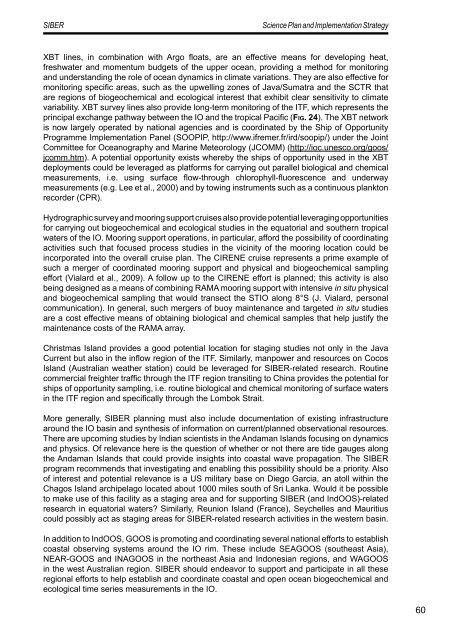SIBER SPIS sept 2011.pdf - IMBER
SIBER SPIS sept 2011.pdf - IMBER
SIBER SPIS sept 2011.pdf - IMBER
Create successful ePaper yourself
Turn your PDF publications into a flip-book with our unique Google optimized e-Paper software.
<strong>SIBER</strong><br />
Science Plan and Implementation Strategy<br />
XBT lines, in combination with Argo floats, are an effective means for developing heat,<br />
freshwater and momentum budgets of the upper ocean, providing a method for monitoring<br />
and understanding the role of ocean dynamics in climate variations. They are also effective for<br />
monitoring specific areas, such as the upwelling zones of Java/Sumatra and the SCTR that<br />
are regions of biogeochemical and ecological interest that exhibit clear sensitivity to climate<br />
variability. XBT survey lines also provide long-term monitoring of the ITF, which represents the<br />
principal exchange pathway between the IO and the tropical Pacific (Fig. 24). The XBT network<br />
is now largely operated by national agencies and is coordinated by the Ship of Opportunity<br />
Programme Implementation Panel (SOOPIP, http://www.ifremer.fr/ird/soopip/) under the Joint<br />
Committee for Oceanography and Marine Meteorology (JCOMM) (http://ioc.unesco.org/goos/<br />
jcomm.htm). A potential opportunity exists whereby the ships of opportunity used in the XBT<br />
deployments could be leveraged as platforms for carrying out parallel biological and chemical<br />
measurements, i.e. using surface flow-through chlorophyll-fluorescence and underway<br />
measurements (e.g. Lee et al., 2000) and by towing instruments such as a continuous plankton<br />
recorder (CPR).<br />
Hydrographic survey and mooring support cruises also provide potential leveraging opportunities<br />
for carrying out biogeochemical and ecological studies in the equatorial and southern tropical<br />
waters of the IO. Mooring support operations, in particular, afford the possibility of coordinating<br />
activities such that focused process studies in the vicinity of the mooring location could be<br />
incorporated into the overall cruise plan. The CIRENE cruise represents a prime example of<br />
such a merger of coordinated mooring support and physical and biogeochemical sampling<br />
effort (Vialard et al., 2009). A follow up to the CIRENE effort is planned; this activity is also<br />
being designed as a means of combining RAMA mooring support with intensive in situ physical<br />
and biogeochemical sampling that would transect the STIO along 8°S (J. Vialard, personal<br />
communication). In general, such mergers of buoy maintenance and targeted in situ studies<br />
are a cost effective means of obtaining biological and chemical samples that help justify the<br />
maintenance costs of the RAMA array.<br />
Christmas Island provides a good potential location for staging studies not only in the Java<br />
Current but also in the inflow region of the ITF. Similarly, manpower and resources on Cocos<br />
Island (Australian weather station) could be leveraged for <strong>SIBER</strong>-related research. Routine<br />
commercial freighter traffic through the ITF region transiting to China provides the potential for<br />
ships of opportunity sampling, i.e. routine biological and chemical monitoring of surface waters<br />
in the ITF region and specifically through the Lombok Strait.<br />
More generally, <strong>SIBER</strong> planning must also include documentation of existing infrastructure<br />
around the IO basin and synthesis of information on current/planned observational resources.<br />
There are upcoming studies by Indian scientists in the Andaman Islands focusing on dynamics<br />
and physics. Of relevance here is the question of whether or not there are tide gauges along<br />
the Andaman Islands that could provide insights into coastal wave propagation. The <strong>SIBER</strong><br />
program recommends that investigating and enabling this possibility should be a priority. Also<br />
of interest and potential relevance is a US military base on Diego Garcia, an atoll within the<br />
Chagos Island archipelago located about 1000 miles south of Sri Lanka. Would it be possible<br />
to make use of this facility as a staging area and for supporting <strong>SIBER</strong> (and IndOOS)-related<br />
research in equatorial waters Similarly, Reunion Island (France), Seychelles and Mauritius<br />
could possibly act as staging areas for <strong>SIBER</strong>-related research activities in the western basin.<br />
In addition to IndOOS, GOOS is promoting and coordinating several national efforts to establish<br />
coastal observing systems around the IO rim. These include SEAGOOS (southeast Asia),<br />
NEAR-GOOS and INAGOOS in the northeast Asia and Indonesian regions, and WAGOOS<br />
in the west Australian region. <strong>SIBER</strong> should endeavor to support and participate in all these<br />
regional efforts to help establish and coordinate coastal and open ocean biogeochemical and<br />
ecological time series measurements in the IO.<br />
60












